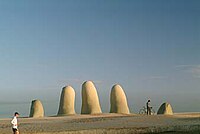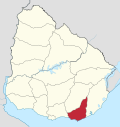Punta del Este: Difference between revisions
| Line 36: | Line 36: | ||
==History== |
==History== |
||
The first Europeans to set foot in what is now Punta del Este were the Spanish at the beginning of the 16th century. However, the colonization of the area actually began around Maldonado at the end of the 18th century due to Portuguese expansionism. {{Citation needed|date=January 2010}} Punta del Este and its surroundings (Maldonado and Punta Ballena for example) at the end of the 19th century were kilometers of sand and dunes, but in 1896 [[Antonio Lussich]] bought 4,447 acres (1800 hectares) of uninhabited land and there he started a botanic garden and planted trees and plants from all over the world. {{Citation needed|date=June 2009}} Later the trees started to spread on their own, and now the area is full mostly of [[Pine]]s, [[Eucalyptus]], [[Acacia longifolia|Acacias]] and various species of [[Shrub|bushes]]. Its status was elevated to "City" category 2 July 1957 by decree Ley No. 12.397.<ref>{{cite web |url=http:// |
The first Europeans to set foot in what is now Punta del Este were the Spanish at the beginning of the 16th century. However, the colonization of the area actually began around Maldonado at the end of the 18th century due to Portuguese expansionism. {{Citation needed|date=January 2010}} Punta del Este and its surroundings (Maldonado and Punta Ballena for example) at the end of the 19th century were kilometers of sand and dunes, but in 1896 [[Antonio Lussich]] bought 4,447 acres (1800 hectares) of uninhabited land and there he started a botanic garden and planted trees and plants from all over the world. {{Citation needed|date=June 2009}} Later the trees started to spread on their own, and now the area is full mostly of [[Pine]]s, [[Eucalyptus]], [[Acacia longifolia|Acacias]] and various species of [[Shrub|bushes]]. Its status was elevated to "City" category 2 July 1957 by decree Ley No. 12.397.<ref>{{cite web |url=http://www0.parlamento.gub.uy/leyes/AccesoTextoLey.asp?Ley=12397 |title= LEY N° 12.397 |publisher= República Oriental del Uruguay, Poder Legislativo |year=1957 |accessdate=10 July 2011}}</ref> |
||
Punta del Este hosted an American Summit in 1967 attended by U.S. President [[Lyndon Johnson]].<ref>http://www.state.gov/r/pa/ho/trvl/pres/12796.htm</ref> In September 1986, Punta del Este played host to the start of the [[Uruguay Round]] of international trade negotiations. These negotiations ultimately led to the creation of the [[World Trade Organization]] in 1994. |
Punta del Este hosted an American Summit in 1967 attended by U.S. President [[Lyndon Johnson]].<ref>http://www.state.gov/r/pa/ho/trvl/pres/12796.htm</ref> In September 1986, Punta del Este played host to the start of the [[Uruguay Round]] of international trade negotiations. These negotiations ultimately led to the creation of the [[World Trade Organization]] in 1994. |
||
Revision as of 16:32, 4 February 2012
Punta del Este | |
|---|---|
City | |
 Port of Punta del Este | |
| Country | |
| Department | Maldonado Department |
| Founded | 1907 |
| Government | |
| • Mayor(Alcalde) | Martín Laventure (National Party (Uruguay)) |
| Population (2004) | |
| • Total | 7,298 |
| • Demonym | Puntaesteño |
| Time zone | UTC -3 |
| postal code | 20100 |
| Area code | +598 42 |
Punta del Este is a resort town on the Atlantic Coast in the Maldonado Department of southeastern Uruguay. It is located on the intersection of Route 10 with Route 39, directly southeast of the department capital Maldonado and about 140 kilometres (87 mi) east of Montevideo. Although the city has a year-round population of about 7,300,[1] the summer tourist boom often boosts the population by an extra 150,000.[2]
History
The first Europeans to set foot in what is now Punta del Este were the Spanish at the beginning of the 16th century. However, the colonization of the area actually began around Maldonado at the end of the 18th century due to Portuguese expansionism. [citation needed] Punta del Este and its surroundings (Maldonado and Punta Ballena for example) at the end of the 19th century were kilometers of sand and dunes, but in 1896 Antonio Lussich bought 4,447 acres (1800 hectares) of uninhabited land and there he started a botanic garden and planted trees and plants from all over the world. [citation needed] Later the trees started to spread on their own, and now the area is full mostly of Pines, Eucalyptus, Acacias and various species of bushes. Its status was elevated to "City" category 2 July 1957 by decree Ley No. 12.397.[3]
Punta del Este hosted an American Summit in 1967 attended by U.S. President Lyndon Johnson.[4] In September 1986, Punta del Este played host to the start of the Uruguay Round of international trade negotiations. These negotiations ultimately led to the creation of the World Trade Organization in 1994.
| Punta del Este | ||||||||||||||||||||||||||||||||||||||||||||||||||||||||||||
|---|---|---|---|---|---|---|---|---|---|---|---|---|---|---|---|---|---|---|---|---|---|---|---|---|---|---|---|---|---|---|---|---|---|---|---|---|---|---|---|---|---|---|---|---|---|---|---|---|---|---|---|---|---|---|---|---|---|---|---|---|
| Climate chart (explanation) | ||||||||||||||||||||||||||||||||||||||||||||||||||||||||||||
| ||||||||||||||||||||||||||||||||||||||||||||||||||||||||||||
| ||||||||||||||||||||||||||||||||||||||||||||||||||||||||||||
Climate
Punta del Este has a mild oceanic climate (Cfb, according to the Köppen climate classification), with pleasant summers and cool winters. The precipitation is evenly distributed throughout the year, with an average of 1,010 mm (39,76 in). The hottest month, January, has an average temperature of 21.7 °C (71 °F), and the coldest month, July, has an average of 11.5 °C (52.7 °F). The average yearly temperature is 16.6 °C (61.88 °F).
Demographics
Population
In 2004, Punta del Este had a population of 7,298.[1] During the 2004 census, there were 2,943 households in the department. The average household size was 2.4 persons. For every 100 females, there were 91.6 males.[5]
| Year | Population |
|---|---|
| 1963 | 4,503 |
| 1975 | 7,197 |
| 1985 | 6,731 |
| 1996 | 8,294 |
| 2004 | 7,298 |
Source: Instituto Nacional de Estadística de Uruguay[6]

The Beach

Punta del Este has scenic coasts and beaches. There are two types of coastlines: Brava and Mansa. This shows the end of the Río de la Plata (River Plate) on one side and the beginning of the Atlantic Ocean, on the other side. Every beach of the peninsula has public access. There are quiet and calm water beaches while others have strong waves, white and fine sand or thick and golden ones. The split between wave types is around the Monumento al Ahogado, which the sculptor designed to warn swimmers that the rough waves could cause them to drown.
La Barra is popular for nautical sports and fishing. Other areas include El Tesoro resort, Montoya beach, Bikini beach and Manantiales beach. Nowadays this area has become an important tourist centre.
Main Sites

The city has much colonial architecture contrasting with more modern buildings. Nowadays it has a scenic shore, typical resort houses, modern buildings, a port with mooring capacity, department stores, restaurants, and pubs. There are several large houses, and gardens lined with plants.
Gorlero Avenue, the main avenue of Punta del Este has commercial galleries, restaurants, cinemas, casinos, shops.
Artigas square, over Gorlero Ave is the place where there is a popular handicraft market.
Casapueblo
This icon of Punta del Este is an artwork by the Uruguayan painter and sculptor Carlos Páez Vilaró. It sits atop Punta Ballena, as one of the main attractions of the peninsula. The artist began working on the project in 1958, and took 36 years to be completed.
It is universally considered as a “living sculpture”. Inside this masterpiece there are many rooms facing the sea. It also boasts sculptures, paintings and ceramics made by its creator. During the summer season there are sunset classical music concerts. It is possible to view the sunrise over the Atlantic Ocean and the sunset over the Río de la Plata in Punta Ballena.
Punta del Este Lighthouse
The lighthouse is 45 metres tall, and the crystal panels which are part of its illumination system were brought from France. It works by electricity, with acetylene gas as emergency backup. It is possible to climb the 150 steps of its spiral staircase.[7]


Gorriti Island
This island of 21 hectares of surface is daily visited to enjoy its two beaches: Garden Port and Honda beach. It consists of a natural port, with ships anchoring close to it, and it also became a popular area to practice water sports.
Transportation
The city is served by Capitán de Corbeta Carlos A. Curbelo International Airport, being the second most important of Uruguay, located near Laguna del Sauce on the outskirts of the city. This modern airport opened in 1996. It offers domestic and international flights within the region.
Punta del Este can be reached from Buenos Aires by ferryboat to Montevideo (the capital city), 140 km from Punta del Este, and then by car or bus.
Notable visitors
- Albert II, Prince of Monaco
- Ricardo Arjona
- Kevin Bacon
- Luciano Benetton
- George W. Bush
- Gerard Butler
- Naomi Campbell
- Eric Clapton
- George Clooney
- Bob Dylan
- Lola Dueñas
- Gloria Estefan
- Morgan Freeman
- Gloria Gaynor
- Melissa George
- David Guetta
- Eva Herzigová
- James Hetfield
- Paris Hilton
- Enrique Iglesias
- Julio Iglesias
- Heidi Klum
- Cyndi Lauper
- Ralph Lauren
- Diego Maradona
- Ricky Martin
- Luis Miguel
- Liza Minnelli
- Olivia Newton-John
- Tara Reid
- Mickey Rourke
- Paulina Rubio
- Marat Safin
- Kyra Sedgwick
- Shakira
- Bob Sinclar
- Tiësto
- Uma Thurman
- Mario Vargas Llosa
- Marlon Wayans
- Bruce Willis
- Ron Wood
- Zinedine Zidane
- Mark Zuckerberg
Twin towns – Sister cities
Punta del Este is twinned with:
 Marbella, Spain
Marbella, Spain
See also
References
- ^ a b "2004 Census of Maldonado department Frame 7" (XLS). INE. 2004. Retrieved 7 July 2011.
- ^ "Party continues despite recession". BBC News. 12 August 2009. Retrieved 10 June 2011.
- ^ "LEY N° 12.397". República Oriental del Uruguay, Poder Legislativo. 1957. Retrieved 10 July 2011.
- ^ http://www.state.gov/r/pa/ho/trvl/pres/12796.htm
- ^ "2004 Census of Maldonado department Frame 9" (XLS). INE. 2004. Retrieved 10 July 2011.
- ^ "1963–1996 Statistics / P" (DOC). Instituto Nacional de Estadística de Uruguay. 2004. Retrieved 7 July 2011.
{{cite web}}: Italic or bold markup not allowed in:|publisher=(help) - ^ Secretaría de Comunicaciones y Prensa. "Ciudad de Punta del Este : Faro de Punta del Este" (in Spanish). IMM. Retrieved September 10, 2010.
External links
- Punta del Este website
- Official site of Maldonado department
- Everything you need to know about Punta del Este
- Information for tourists and travellers about Punta del Este
- Template:Wikitravel
- Correo Uruguayo - Stamp for the 100 years of Punta del Este, with notes on its history.
- Article on the Port of Punta del Este, Official Portal of the Uruguayan Government
- INE map of Punta del Este

